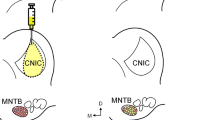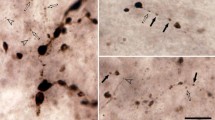Abstract
Vibrissae are a unique sensory system of mammals that is characterized by a rich and diverse innervation involved in numerous sensory tasks with the potential for species-specific differences. In the present study, indocarbocyanine dyes (DiI and PTIR271) and confocal microscopy were combined to study the innervation of the mystacial vibrissae and vibrissa-specific sensory neuron distribution in the maxillary portion of the trigeminal ganglion of the mouse. The deeper regions of the vibrissa cavernous sinus (CS) contained a dense plexus of free nerve endings, possibly of autonomic fibers. The superficial part of this sinus displayed a massive array of corpuscular endings. Innervation in the region of the ring sinus consisted of Merkel endings and different morphological variances of lanceolate endings. The region of the inner conical body had a circular plexus of free nerve endings. In addition to confirming previous observations obtained by a variety of other techniques and ultrastructural studies, our studies revealed denser terminal receptor endings in a different distribution pattern than previously demonstrated in studies using the rat. We also revealed the distribution of sensory neurons in the trigeminal ganglion using retrograde tracing with fluorescent tracers from two nearby vibrissae. We determined that the populations of sensory neurons innervating the two vibrissae were largely overlapping. This suggests that the somatotopic maps of vibrissal projections reported at the different levels in the neuraxis are not faithfully reproduced at the level of the ganglion.






Similar content being viewed by others
References
Agmon A, Yang LT, Jones EG, O’Dowd DK (1995) Topological precision in the thalamic projection to neonatal mouse barrel cortex. J Neurosci 15:549–561
Andres KH (1966) [On the microstructure of receptors on sinus hair]. Z Zellforsch Mikrosk Anat 75:339–365
Arvidsson J, Rice FL (1991) Central projections of primary sensory neurons innervating different parts of the vibrissae follicles and intervibrissal skin on the mystacial pad of the rat. J Comp Neurol 309:1–16
Dehnhardt G, Hyvarinen H, Palviainen A, Klauer G (1999) Structure and innervation of the vibrissal follicle-sinus complex in the Australian water rat, Hydromys chrysogaster. J Comp Neurol 411:550–562
Dorfl J (1982) The musculature of the mystacial vibrissae of the white mouse. J Anat 135:147–154
Dykes RW (1975) Afferent fibers from mystacial vibrissae of cats and seals. J Neurophysiol 38:650–662
Dykes RW, Dudar JD, Tanji DG, Publicover NG (1977) Somatotopic projections of mystacial vibrissae on cerebral cortex of cats. J Neurophysiol 40:997–1014
Ebara S, Kumamoto K, Matsuura T (1992) [Peptidergic innervation in the sinus hair follicles of several mammalian species]. Kaibogaku Zasshi 67:623–633
Ebara S, Kumamoto K, Matsuura T, Mazurkiewicz JE, Rice FL (2002) Similarities and differences in the innervation of mystacial vibrissal follicle-sinus complexes in the rat and cat: a confocal microscopic study. J Comp Neurol 449:103–119
Erzurumlu RS, Killackey HP (1983) Development of order in the rat trigeminal system. J Comp Neurol 213:365–380
Erzurumlu RS, Bates CA, Killackey HP (1980) Differential organization of thalamic projection cells in the brain stem trigeminal complex of the rat. Brain Res 198:427–433
Fraser SE, Hunt RK (1980) Retinotectal specificity: models and experiments in search of a mapping function. Annu Rev Neurosci 3:319–352
Fritzsch B (1999) Ontogenetic and evolutionary evidence for the motoneuron nature of vestibular and cochlear efferents. In: Berlin CI (ed) The efferent auditory system: Basic science and clinical applications. Singular Publishing, San Diego, pp 31–59
Fritzsch B, Muirhead KA, Gray B, Maklad A (2002) Diffusion and imaging properties of three new lipophilic tracers, PKH2, PKH26, and PTIR271, and their use for triple labeling of neuronal profiles. Soc Neurosci Abstr 32:519
Fundin BT, Rice FL, Pfaller K, Arvidsson J (1994) The innervation of the mystacial pad in the adult rat studied by anterograde transport of HRP conjugates. Exp Brain Res 99:233–246
Gottschaldt KM, Iggo A, Young DW (1973) Functional characteristics of mechanoreceptors in sinus hair follicles of the cat. J Physiol 235:287–315
Halata Z, Munger BL (1980) Sensory nerve endings in rhesus monkey sinus hairs. J Comp Neurol 192:645–663
Jacquin MF, Woerner D, Szczepanik AM, Riecker V, Mooney RD, Rhoades RW (1986) Structure-function relationships in rat brainstem subnucleus interpolaris. I. Vibrissa primary afferents. J Comp Neurol 243:266–279
Killackey HP (1973) Anatomical evidence for cortical subdivisions based on vertically discrete thalamic projections from the ventral posterior nucleus to cortical barrels in the rat. Brain Res 51:326–331
Killackey HP, Leshin S (1975) The organization of specific thalamocortical projections to the posteromedial barrel subfield of the rat somatic sensory cortex. Brain Res 86:469–472
Maklad A, Fritzsch B (2002) The developmental segregation of posterior crista and saccular vestibular fibers in mice: a carbocyanine tracer study using confocal microscopy. Brain Res Dev Brain Res 135:1–17
Maklad A, Fritzsch B (2003) Partial segregation of posterior crista and saccular fibers to the nodulus and uvula of the cerebellum in mice, and its development. Brain Res Dev Brain Res 140:223–236
Maklad A, Quinn T, Fritzsch B (2001) Intracranial distribution of the sympathetic system in mice: DiI tracing and immunocytochemical labeling. Anat Rec 263:99–111
Melarango HP, Montagna W (1953) The tactile hair follicles in the mouse. Anat Rec 115:129–149
Mosconi TM, Rice FL, Song MJ (1993) Sensory innervation in the inner conical body of the vibrissal follicle-sinus complex of the rat. J Comp Neurol 328:232–251
Nussbaumer JC, Van der Loos H (1985) An electrophysiological and anatomical study of projections to the mouse cortical barrelfield and its surroundings. J Neurophysiol 53:686–698
Patrizi G, Munger BL (1966) The ultrastructure and innervation of rat vibrissae. J Comp Neurol 126:423–435
Renehan WE, Munger BL (1986) Degeneration and regeneration of peripheral nerve in the rat trigeminal system. I. Identification and characterization of the multiple afferent innervation of the mystacial vibrissae. J Comp Neurol 246:129–145
Rhoades RW, Chiaia NL, MacDonald GJ (1990) Topographic organization of the peripheral projections of the trigeminal ganglion in the fetal rat. Somatosens Mot Res 7:67–84
Rice FL, Mance A, Munger BL (1986) A comparative light microscopic analysis of the sensory innervation of the mystacial pad. I. Innervation of vibrissal follicle-sinus complexes. J Comp Neurol 252:154–174
Rice FL, Fundin BT, Arvidsson J, Aldskogius H, Johansson O (1997) Comprehensive immunofluorescence and lectin binding analysis of vibrissal follicle sinus complex innervation in the mystacial pad of the rat. J Comp Neurol 385:149–184
Rubel EW, Fritzsch B (2002) Auditory system development: primary auditory neurons and their targets. Annu Rev Neurosci 25:51–101
Schoultz TW, Swett JE (1972) The fine structure of the Golgi tendon organ. J Neurocytol 1:1–26
Takahashi-Iwanaga H (2000) Three-dimensional microanatomy of longitudinal lanceolate endings in rat vibrissae. J Comp Neurol 426:259–269
Van der Loos H (1976) Barreloids in mouse somatosensory thalamus. Neurosci Lett 2:1–6
Van der Loos H, Woolsey TA (1973) Somatosensory cortex: structural alterations following early injury to sense organs. Science 179:395–398
Vincent S (1913) The tactile hair of the white rat. J Comp Neurol 23:1–36
Woolsey TA, Van der Loos H (1970) The structural organization of layer IV in the somatosensory region (SI) of mouse cerebral cortex. The description of a cortical field composed of discrete cytoarchitectonic units. Brain Res 17:205–242
Wrobel KH (1965) Structure and significance of the blood sinus in vibrissae of Tupaia glis. Zentralbl Veterinarmed A 12:888–899
Acknowledgements
The authors express their gratitude to Drs. B. Gray and K.A. Muirhead for the use of PTIR271 and to M. Hendrickson for his assistance.
Author information
Authors and Affiliations
Corresponding author
Additional information
This work was supported by a grant from the NIDCD (RO1 DC 005590; BF), the Egyptian government (AM), and the NIH (ES00365-01 and RR-02-003; LH).
Rights and permissions
About this article
Cite this article
Maklad, A., Fritzsch, B. & Hansen, L.A. Innervation of the maxillary vibrissae in mice as revealed by anterograde and retrograde tract tracing. Cell Tissue Res 315, 167–180 (2004). https://doi.org/10.1007/s00441-003-0816-z
Received:
Accepted:
Published:
Issue Date:
DOI: https://doi.org/10.1007/s00441-003-0816-z




